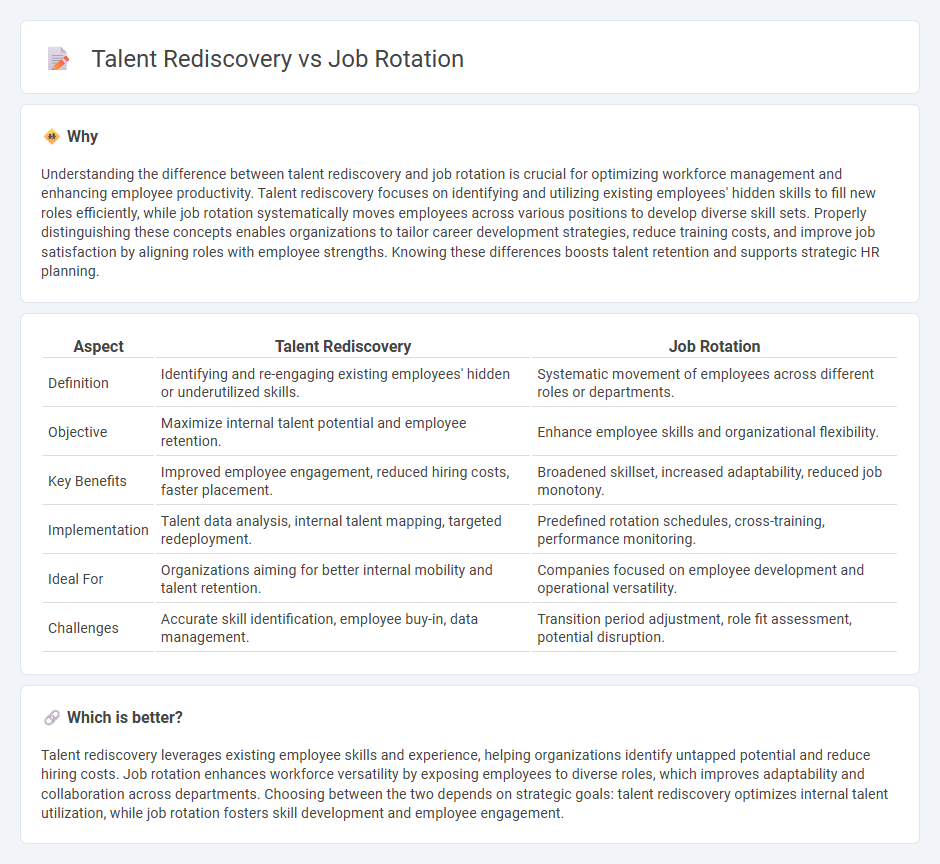
Talent rediscovery focuses on identifying and leveraging existing employees' hidden skills and experiences to fill new roles or projects, enhancing workforce agility and retention. Job rotation systematically moves employees across different roles or departments to develop versatile skills, broaden organizational knowledge, and prevent job monotony. Explore how combining talent rediscovery with job rotation strategies can optimize employee potential and business performance.
Why it is important
Understanding the difference between talent rediscovery and job rotation is crucial for optimizing workforce management and enhancing employee productivity. Talent rediscovery focuses on identifying and utilizing existing employees' hidden skills to fill new roles efficiently, while job rotation systematically moves employees across various positions to develop diverse skill sets. Properly distinguishing these concepts enables organizations to tailor career development strategies, reduce training costs, and improve job satisfaction by aligning roles with employee strengths. Knowing these differences boosts talent retention and supports strategic HR planning.
Comparison Table
| Aspect | Talent Rediscovery | Job Rotation |
|---|---|---|
| Definition | Identifying and re-engaging existing employees' hidden or underutilized skills. | Systematic movement of employees across different roles or departments. |
| Objective | Maximize internal talent potential and employee retention. | Enhance employee skills and organizational flexibility. |
| Key Benefits | Improved employee engagement, reduced hiring costs, faster placement. | Broadened skillset, increased adaptability, reduced job monotony. |
| Implementation | Talent data analysis, internal talent mapping, targeted redeployment. | Predefined rotation schedules, cross-training, performance monitoring. |
| Ideal For | Organizations aiming for better internal mobility and talent retention. | Companies focused on employee development and operational versatility. |
| Challenges | Accurate skill identification, employee buy-in, data management. | Transition period adjustment, role fit assessment, potential disruption. |
Which is better?
Talent rediscovery leverages existing employee skills and experience, helping organizations identify untapped potential and reduce hiring costs. Job rotation enhances workforce versatility by exposing employees to diverse roles, which improves adaptability and collaboration across departments. Choosing between the two depends on strategic goals: talent rediscovery optimizes internal talent utilization, while job rotation fosters skill development and employee engagement.
Connection
Talent rediscovery leverages internal data to identify employees' hidden skills and underutilized potential, enhancing workforce productivity. Job rotation facilitates the practical application of these rediscovered talents by exposing employees to diverse roles, promoting skill development and organizational agility. This synergy improves employee engagement and helps retain valuable talent while addressing skill shortages within the company.
Key Terms
Skill diversification
Job rotation enhances skill diversification by systematically exposing employees to varied roles and responsibilities across departments, fostering a broad skill set and improving adaptability. Talent rediscovery leverages existing employee skills by identifying and utilizing hidden or underutilized talents within the organization, promoting deeper expertise in specific areas. Explore how combining these approaches can strategically maximize workforce potential and drive organizational growth.
Internal mobility
Job rotation enhances internal mobility by systematically moving employees across different roles, fostering skill diversification and organizational knowledge. Talent rediscovery leverages existing employee capabilities by identifying hidden strengths and aligning them with strategic needs, optimizing workforce potential. Explore these approaches to unlock the full value of your internal talent pool.
Workforce optimization
Job rotation enhances workforce optimization by systematically moving employees across different roles to develop diverse skills and identify hidden potential. Talent rediscovery involves reassessing existing employees' abilities and experiences through data analytics and performance reviews to align talent with optimal job functions. Discover strategies to maximize workforce efficiency through effective job rotation and talent rediscovery approaches.
Source and External Links
Job rotation - Wikipedia - Job rotation is the lateral transfer of employees between jobs without change in rank or salary, used for staffing, employee motivation, managing fatigue, orientation, and career development.
Job rotation | EBSCO Research Starters - Job rotation is a human resources strategy moving employees between jobs to develop skills, reduce burnout, increase satisfaction and flexibility, and benefit both employees and employers.
What is Job Rotation: Types, Training Methods, Benefits, and ... - Job rotation involves moving employees horizontally or vertically within an organization to broaden skills and understanding through exposure to different roles and departments.
 dowidth.com
dowidth.com